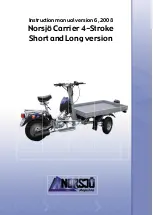
131
NOTE: Whenever brake components are removed,
disassembled, or repaired where brake fluid is
exposed to air, drain all fluid and replace with new
DOT 4 brake fluid from an unopened container. Brake
fluid readily absorbs moisture from the air signifi-
cantly lowering the boiling point. This increases the
chance of vapor lock reducing braking power and
increasing stopping distance.
3. Remove the brake hose from the caliper and close
the bleed screw; then remove the caliper.
4. Compress the caliper holder against the caliper
(opposite the O-ring side) and remove the outer
brake pad; then remove the inner brake pad.
NOTE: If brake pads are to be returned to service,
do not allow brake fluid to contaminate them.
PR237A
PR238
5. Remove the caliper holder from the caliper and dis-
card the O-ring.
PR239B
NOTE: The O-ring is used for shipping purposes
and provides no function in operation.
6. Cover the piston end of the housing with a shop
towel; then keeping fingers clear of piston travel,
apply compressed air to the fluid port to blow the
piston free of the housing. Account for two seal rings
in the housing.
PR713A
PR715
7. Using an appropriate seal removal tool, carefully
remove the seals from the brake caliper housing;
then remove four O-rings from the brake caliper
housing noting the location of the different sized O-
rings. Discard all seals, O-rings, and crush washers.
CLEANING AND INSPECTING
1. Clean all caliper components (except the brake pads)
with DOT 4 brake fluid. Do not wipe dry.
CAUTION
Brake fluid is highly corrosive. Do not spill brake fluid
on any surface of the ATV and do not reuse brake fluid.
! WARNING
Make sure to hold the towel firmly in place or the piston
could be ejected from the housing causing injury.
Manual
Table of Contents
















































